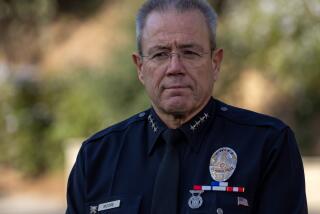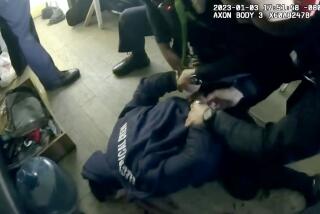Ezell Ford autopsy prompts new protests, calls for caution
The autopsy of Ezell Ford, a mentally ill black man killed by police in South Los Angeles in August, shows he was shot three times -- once in the right side, once in the right back and once in the right arm.
The release of the autopsy Monday marks the first time authorities have provided details about Ford’s wounds since his Aug. 11 death.
The gunshot wound on his back showed the surrounding skin had a “muzzle imprint,” according to the autopsy, suggesting the shot was made at very close range. The autopsy said the back and side gunshot wounds were fatal.
The autopsy does not make any judgment about the conduct of the officers in the shooting or provide a detailed narrative of what occurred.
The report prompted small protests at several locations around Los Angeles. At one point Monday night, a group of demonstrators walked onto the 110 Freeway, briefly blocking some traffic until police arrived and forced them off the roadway.
LAPD Chief Charlie Beck cautioned that the autopsy was just one part of the department’s ongoing investigation into Ford’s death. But he said nothing included in the report was inconsistent with the account provided by his officers.
Beck said the officers had gotten out of their car to speak to Ford but that the 25-year-old walked away. Beck said the officers followed Ford to a nearby driveway, where Ford crouched between a car and some bushes. When one of the officers reached toward Ford, the chief said, he grabbed the officer and forced him to the ground.
Beck said Ford pinned the officer to the ground and tried to remove his handgun from his holster. The officer yelled to his partner that Ford had his gun, Beck said, prompting the officer’s partner to fire two rounds that hit Ford.
The third gunshot came when the officer on the ground grabbed his backup weapon, reached around Ford and fired a close-range shot that struck him in the back.
Beck noted the difficulty the department has had in tracking down eyewitnesses, saying that although the attorney representing Ford’s family had provided the LAPD with a list of witnesses, some had refused to cooperate. He said the department had not contacted a civilian who directly saw the incident.
Beck stressed the investigation into Ford’s death was far from over.
“Let the system work,” he said. “We will find out the truth of what happened on that August night.”
The coroner ruled Ford died of multiple gunshot wounds. The death was classified as a homicide, the standard coroner’s classification for the death of someone by the hand of another. Fatal police shootings, including those later determined to be justified, are routinely ruled as homicides.
The report also notes several abrasions, or scrapes, including to the back of Ford’s left hand, his forearm and elbow, but it does not say what caused them.
Steve Lerman, the attorney representing Ford’s family, described Beck’s comments as “self-serving.” He said the autopsy supported the family’s case against the department and city.
“What the report shows is that Ezell was shot in the back and killed,” Lerman said.
Lerman said that when he went over the report with Ford’s family, his mother was overwhelmed with tears and anger.
The union that represents the LAPD’s rank-and-file said in a statement that the autopsy “only provides one set of facts among many hundreds being collected and assessed in the ongoing investigation concerning Ezell Ford.”
The Los Angeles Police Department has said Ford, 25, was shot while he struggled with two officers and attempted to remove the pistol from the holster of one of them. Other people quoted in news reports after the Aug. 11 shooting disputed the police account.
Los Angeles police had placed a hold on Ford’s autopsy report, asking coroner’s officials not to release information about his wounds.
Beck said the hold was designed to ensure that any witness statements about the fatal encounter between Ford and two veteran gang officers were not influenced by information released publicly about the shooting. Despite repeated public pleas, police officials said investigators had trouble finding people who saw the shooting.
The delayed release angered many residents in South L.A., where Ford’s death exposed lingering tensions between police and the community. Many residents have criticized what they call a lack of transparency by police. The South Central Neighborhood Council unanimously passed a resolution calling for Councilman Curren Price to take action and get the autopsy released.
Last month, Mayor Eric Garcetti ordered the LAPD to make the autopsy public by the end of the year.
In a statement issued Monday, Garcetti cited the importance of making “objective information” available to the public.
“I ordered the autopsy’s release because transparency is key to the trust between the LAPD and the people they serve,” Garcetti said. “That trust is the foundation of a powerful partnership ... It’s important to all of us that this partnership continues.”
The LAPD, the office of inspector general and the district attorney’s office are conducting separate investigations to determine whether the shooting violated department policy or warrants criminal charges against the officers.
Ford was walking home on West 65th Street near Broadway when he was approached by the two gang officers assigned to the LAPD’s Newton division.
Police allege that Ford tackled one of the officers and attempted to grab his gun, prompting the officer to reach for a backup weapon and fire. The officer’s partner also shot at Ford, police said.
But a friend of Ford’s family who said she saw part of the incident told the Los Angeles Times that she saw no struggle.
LAPD officials have not said why the officers approached Ford.
The department has identified the officers as Sharlton Wampler and Antonio Villegas. LAPD records show Wampler has been on the force for 12 years and Villegas for eight.
Both officers have been reassigned to administrative duties, a department spokesman said.
Larry Hanna, the attorney representing the two officers involved in the shooting, declined to comment on the details of the case, but said he was “confident” that once the full investigation was complete, “there will be no wrongdoing by these officers.”
Ford was killed two days after a white police officer shot and killed Michael Brown, a young black man, in Ferguson, Mo. The Missouri shooting sparked national protests and calls for police reform. Ford’s shooting has been invoked along with Brown’s during demonstrations in Los Angeles against police killings.
Ford’s parents have filed a wrongful-death lawsuit against the LAPD, accusing police of racial profiling and using excessive force against their son.
The release of the report comes amid heightened scrutiny of police conduct and, after two officers were killed in New York, growing concerns over police safety.
Small groups of protesters gathered in front of the LAPD’s downtown headquarters and in South Los Angeles on Monday to protest Ford’s death.
Geri Lindo, an amusement park employee and 17-year resident of South L.A., was among the dozens of people gathered in front of the police building. She said she spent six days protesting for the release of Ford’s autopsy, and cried when she finally read it.
“I feel a little numb,” she said. “And this isn’t the first time this happened. So many black men have been killed by the police in Los Angeles.”
At a rally in South L.A.’s Leimert Park, a man sold T-shirts reading “Hands up, don’t shoot” and “I can’t breathe” -- two phrases that have become part of protesters’ vocabulary nationwide after the deaths of Brown in Missouri and Eric Garner in New York. Protesters briefly marched down Crenshaw Boulevard but soon returned to the park, chanting, “It’s a fact, they shot him in the back.”
Najee Ali, an activist who helped organize the event, said the delayed release of the autopsy contradicted the LAPD’s promise of transparency.
“They were stonewalling,” he said. “Using stalling tactics because they knew the report didn’t favor their narrative.”
Others gathered at the corner of 65th and Broadway -- near the site of Ford’s death -- for an early evening vigil. A mural of Ford was painted on a building, with stuffed animals and blue candles stacked below. “In loving memory,” it read.
A half-hour before the vigil was set to begin, Ford’s mother, Tritobia, walked up to the memorial. Her hand shook as she lighted the candles. She then stood up and walked away.
For more crime and LAPD news, follow @katemather @lacrimes and @LATvives.
Times staff writers Angel Jennings, Tre’vell Anderson, Brittny Mejia, Samantha Masunaga and Garrett Therolf contributed to this report.
More to Read
Sign up for Essential California
The most important California stories and recommendations in your inbox every morning.
You may occasionally receive promotional content from the Los Angeles Times.












